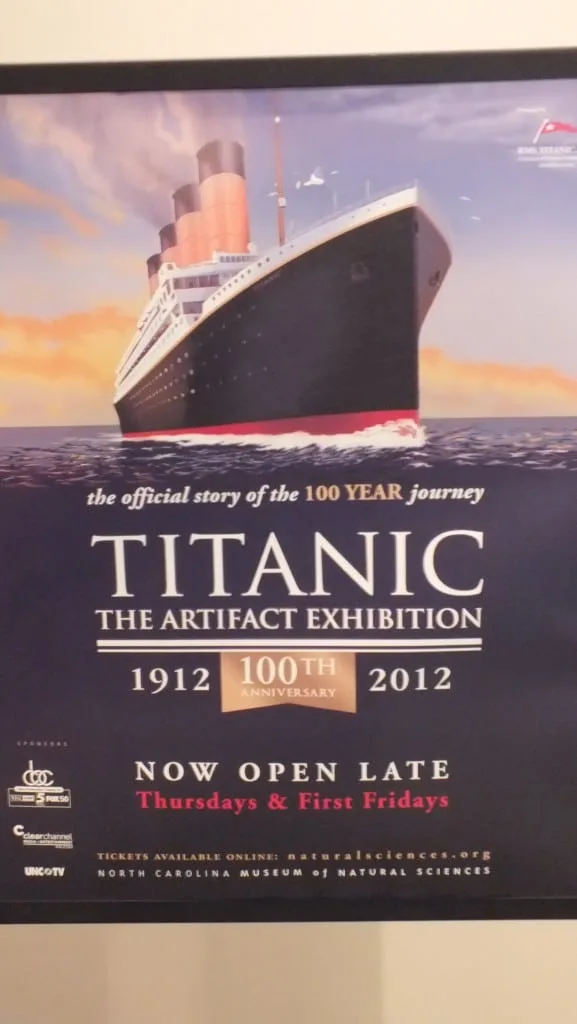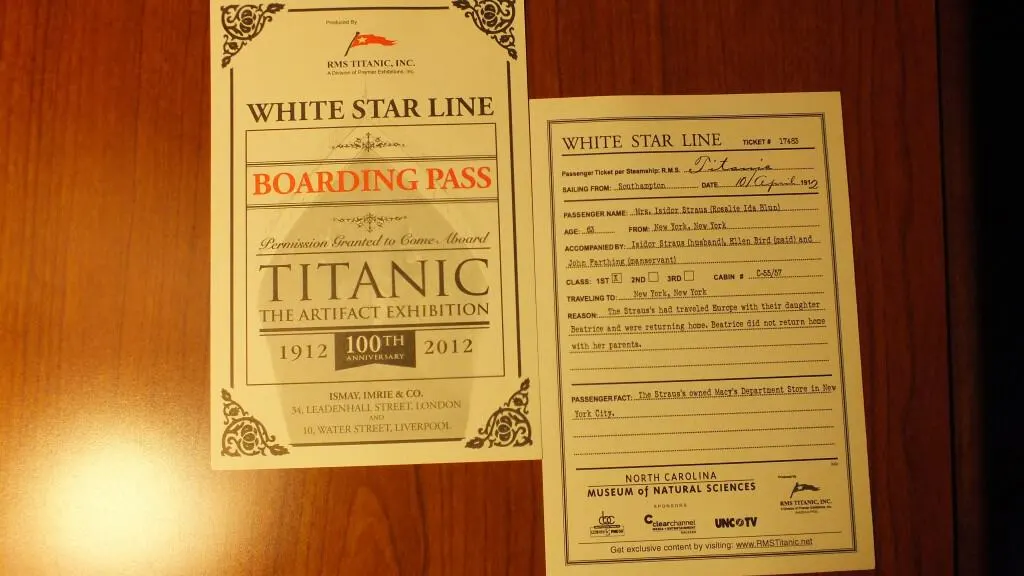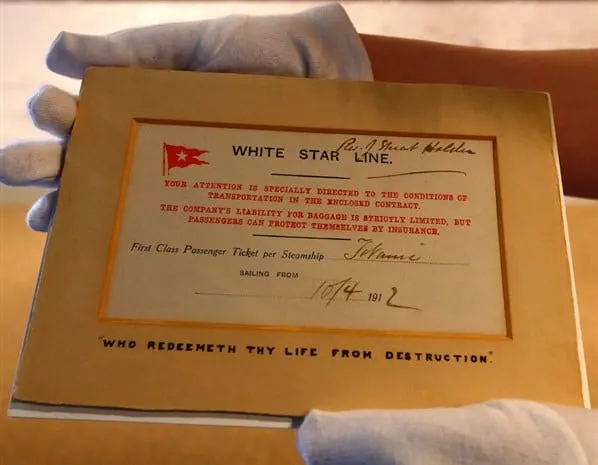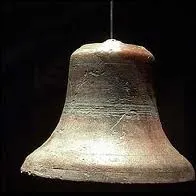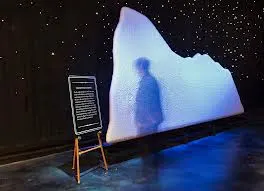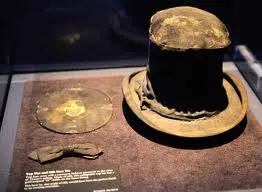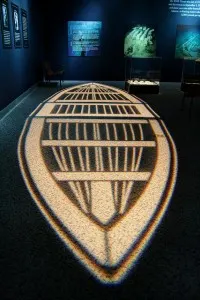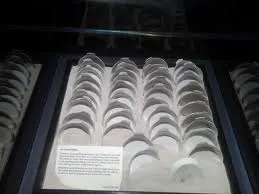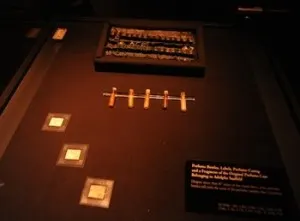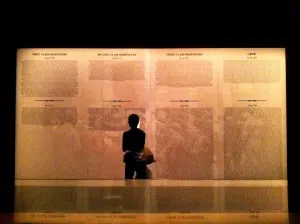The tragedy on April 15, 1912, when a passenger ship, carrying some of the wealthiest people in the world, emigrants and boasting it was nearly unsinkable, made the RMS Titanic the most famous ship in the world. Striking an iceberg on her maiden voyage from Southampton to New York City, 1,502 people perished–more than 100 years later it remains one of the deadliest peacetime maritime disasters in modern history.
Titanic was found September 1, 1985 by the Franco-American expedition 13.2 miles from the inaccurate coordinates given by Titanic‘s radio operators on the night of her sinking, about 1,250 miles (2,000 km) from New York.
The ship rests in two pieces about 1/3 of a mile a part. Scattered in an area about 5 feet by 3 feet are hundreds of thousands of items: pieces of the ship, furniture, dinnerware and personal items, which fell from the ship as she sank or were ejected when the bow and stern impacted on the sea floor. It is also the last resting place of a number of Titanic‘s victims, long since gone, consumed by the sea and its creatures.
Many artifacts from Titanic have been recovered from the sea bed by RMS Titanic Inc., which exhibits them in touring exhibitions around the world. Over the weekend we were fortunate enough to see the Titanic Artifacts Exhibit at the North Carolina Museum of Natural Science.
On the way we talked about everything we knew about the Titanic, which was relatively little, but it gave the children a sense of anticipation for the exhibit and why it was on exhibit.
At the entrance, each of us was handed a replica boarding pass.
The front of the faux boarding pass gave details of the voyage, while the back had us assume the identity of a real Titanic passenger. The children and I each took on the life of a real passenger. We were each in a different class on our voyage…first, second and third class.
All boarding passes at the exhibit looked the same, and nothing like this, only known surviving first class ticket from Titanic, which is on display at the Merseyside Maritime Museum.
We entered the exhibit and were transported back in time.
We stepped back to meet Edward James Harland and Gustav Wilhelm Wolff of the Harland and Wolff shipyard in Belfast where the RMS Titanic was built. The Titanic construction was the work of Lord William Pirrie (director of Harland Wolf and White Star), naval architect Thomas Andrews (Harland Wolf construction manager), and Alexander Carlisle, the shipyard’s chief draughtsman and general manager.
We took center stage as we read and viewed photos of the Construction of RMS Titanic, funded by the American J.P. Morgan and his International Mercantile Marine Co., began on 31 March, 1909.
We met the RMS Titanic up close from her size, 882.9 feet long and 92 feet wide, 59 feet high from water level, and weighed over 46,328 tons. We learned about her guts: there were 29 boilers fired by 159 coal-burning furnaces that made possible a top speed of 23 knots ( 26 mph).
We came to know she could carry 3,547 passengers and crew as we stepped on to her in our imagination.
Here, in the exhibit, the air was controlled, but it was easy to imagine the salty smell of the ocean on April 10, 1912 in Southampton. We were in awe at this feat of human engineering that had created the largest and most luxurious ocean liner in the world at the time.
While the Titanic’s Cargo hook and pulley rested in a glass case, it was easy to visualize it overhead carrying trunks and cargo on board the ship.
We saw the original bell that rang during the maiden voyage. Her brass now tarnished.
We made our way into the room where the music played, just as it would have on the Titanic, where we met the wealthy.

John Jacob Astor IV, American businessman, real estate builder, investor, inventor, writer, and lieutenant colonel. Not only was he the richest passenger aboard the Titanic, he was considered the richest person in the world at the time. He died in the sinking. His wife, who was seven month’s pregnant, survived.
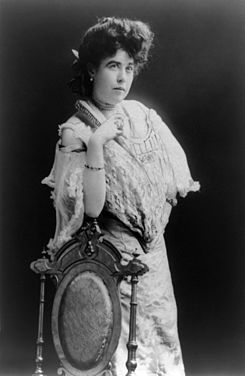
Margaret “Molly” Brown, American socialite, philanthropist, and activist who became famous due to exhorting the crew of Lifeboat No. 6 to return to look for survivors. She became known after her death as “The Unsinkable Molly Brown”, although during her life, her friends called her “Maggie”.

American businessman, Benjamin Guggenheim, who upon learning his fate would be to go down with the Titanic, said, “We’ve dressed in our best, and are prepared to go down like gentlemen. There is grave doubt that the men will get off. I am willing to remain and play the man’s game if there are not enough boats for more than the women and children. I won’t die here like a beast. Tell my wife I played the game out straight and to the end. No women shall be left aboard this ship because Ben Guggenheim was a coward.”
We learned a first class ticket was the equivalent of $135,000 in today’s market.
Then we learned about the Second and Third Class passengers.
The children were fascinated by playing cards…
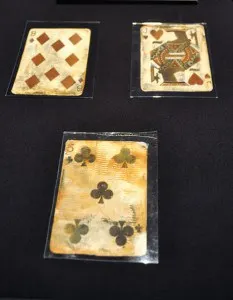
playing cards on display at the Titanic: The Artifact Exhibition in Singapore (photo by Leone Fabre)
We imagined hot chocolate in the White Star Line’s cups..
We transported to a Third Class Cabin. Third class passengers shared rooms with modest amenities on board. Titanic was equipped with two bathtubs for more than 700 third class passengers. There was noise like the passengers would have heard broadcast through speakers making it a true-to-life exhibit.
We entered the Boiler room next. With reflections of red the room offered a glimpse into how the Titanic ran and a perspective of her laborers. For the Titanic to move from England to New York, 5 millions tons of coal were necessary. Full speed (1.5km) required 6,000 tons of coal.
From the boiler room, we stepped on to the promenade deck. It was one of my favorite places in the exhibit. It was set up with views that would have been similar to the night of April 12,1912. Jet black sky, scattered with sparkling stars. The scattered quotes against the walls made it a sobering place.
From the deck you could see the iceberg. It was a chance to touch a wall of ice and test the ability to withstand the contact with freezing temperatures. Within a few minutes Li’l Man was letting go saying, “It hurts!” While it was fun to experiment, the reality is that with water temperatures -1 Celsius within 40 minutes, hypothermia set in and the Titanic’s passengers were victims of the freezing water. It was awe-inspiring to experience a fraction of that moment on April 12, 1912. The hand prints left by fellow tourists were eerie.
So perfectly orchestrated was this exhibit of artifacts that in the room with the ice wall are cases filled with items from the ship, seemingly scattered about in the commotion and chaos of that moment more than 100 years ago. Items like a single boot, spectacles, sheet music and a top hat…
It is easy to remember these items once belonged to someone.
Looking at the sheet music in this room, transported me back to one of the first rooms in the exhibit. The room where we met the wealthy and heard the orchestra playing. Being in this last room, the chaos easily imagined, the ship’s orchestra becomes a distant memory. They weren’t really part of the crew. These eight men, ranging in age from 20-33, also weren’t really passengers. They remained in place, playing as long as they could, as the lifeboats were being lowered. It is said Wallace Hartley, the orchestra’s leader, may have conducted Nearer My God to Thee, a song he wanted performed at his own funeral, as their last song.
From the sinking of the ship, we leave 1912 and exit into a room that has a life boat projected in light on the floor. It gives a glimpse of how big the lifeboats were, how many people could have fit into one. It brings forward memories that these lifeboats, filled mostly with woman and children, were at most, half-capacity when they left the RMS Titanic.
Against the wall next to the projection life boat we meet three passengers, including Margaret Brown, and read their stories of survival.
Then we jump to 1985, when the Titanic was found in her resting place. We see exhibit cases filled with treasures, such as these au gratin dishes, line perfectly like dominoes
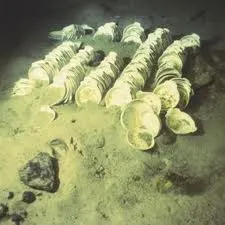 And on the wall just behind them, we see them as they were discovered two miles below the ocean’s surface…
And on the wall just behind them, we see them as they were discovered two miles below the ocean’s surface…
This theme is carried on as we see a bench and giant pots.
The children were excited to be able to stretch their fingers inside an exhibit case to touch a recovered piece of the Titanic..
We wandered from the dive site and toured personal belongings recovered from the site. These exhibition cases included a recreation of the person and the belongings. One of the most incredible was the story of the perfume bottles
Adolphe Saalfeld was a perfume maker from Manchester, England. At the age of 47, he boarded Titanic as a first-class passenger. He carried with him a leather satchel filled with perfume samples. At the time Titanic sailed, the American perfume market was booming. He may have planned to sell his perfumes to fashion boutiques and department stores in New York and other major cities. Adolphe Saalfeld survived the sinking but left his samples behind. Of the 65 vials that Saalfeld packed in his luggage, 62 have been recovered. These perfume vials have never been on public display.
We were also acquainted with the oldest living survivor, Millvina Dean, just two months old at the time of the Titanic’s maiden voyage, she was the youngest passenger aboard. Her parents had decided to leave England and emigrate to Wichita, Kansas, where her father had family and his cousin owned a tobacco shop that her father was going to co-own.] The Deans were not supposed to be aboard the Titanic, but owing to a coal strike, they were transferred to the ship and boarded it as third-class passengers at Southampton, England. Her father felt the ship’s collision with the iceberg on the night of 14 April 1912, and after investigating, returned to his cabin telling his wife to dress the children and go up on deck. Dean, her mother, and brother were placed in Lifeboat 13 and were among the first steerage passengers to escape the sinking ocean liner. Her father, however, did not survive, and his body, if recovered, was never identified.
Dean passed away May 30, 2009. She was the last living passenger from the RMS Titanic.
As we prepared to exit the exhibit, we stopped at the Memorial Wall. It lists every passenger on the Titanic. Walking towards it, my heart grew heavy. There in print was the segregation of its passenger. Not just in class but in survival. The list of the deceased increasing as the class is lowered.
If the wall doesn’t make it evident, here is a quick look at the statistics by class:
| 1st Class On Board | 1st Class Survived | 2nd Class On Board | 2nd Class Survived | 3rd Class On Board | 3rd Class Survived | Crew On Board | Crew Survived | |
| Men | 175 | 57 | 168 | 14 | 462 | 75 | 192 | |
| Women | 144 | 140 | 93 | 80 | 165 | 76 | 23 | |
| Children | 6 | 5 | 24 | 24 | 79 | 27 | ||
| Total | 325 | 202 | 285 | 118 | 706 | 178 | 913 | 215 |
| Total Passengers = 1316 | Total Crew = 913 | |||||||
| Total Survived = 498 | Total Survived = 215 | |||||||
| Total On Board Titanic = 2229 | ||||||||
| Total Survivors = 713 | ||||||||
The children and I found our names on our boarding pass and then searched for our names. I imagine it would have been a simulation of families of loved ones aboard the RMS Titanic, searching for the names of their loved ones.
We were among the Third Class, the Second Class and the First Class, Isidore Straus, was one of our names.
Of the three of us, none of us survived.
This was an incredible exhibit and very interactive. If the Titanic Artifact Exhibition is near you, it’s worth seeing. It’s an incredible tribute to a ship, her crew and her passengers.


